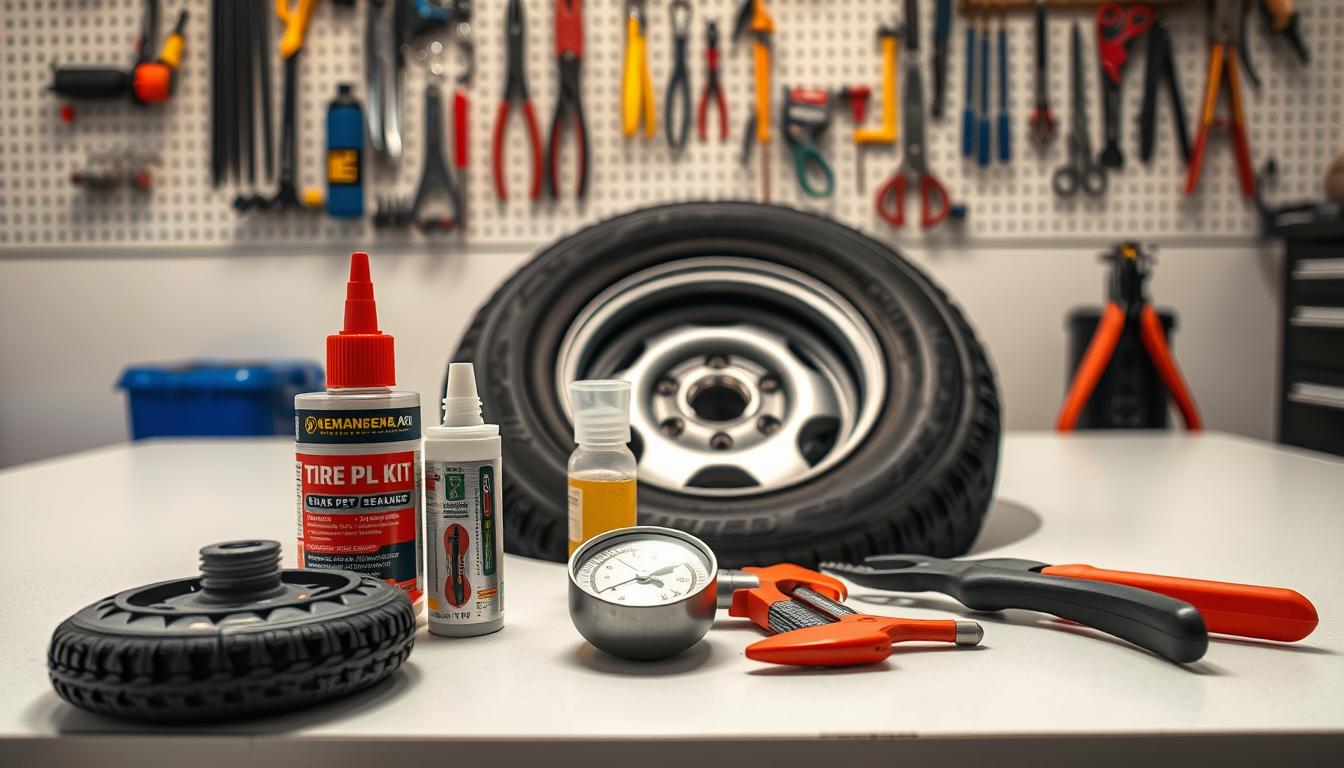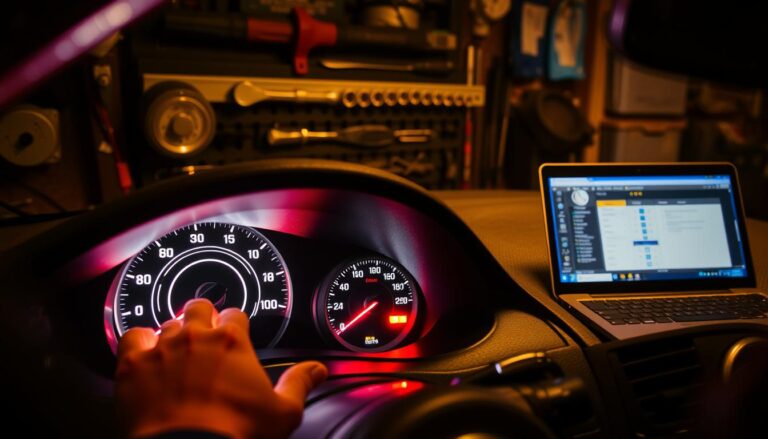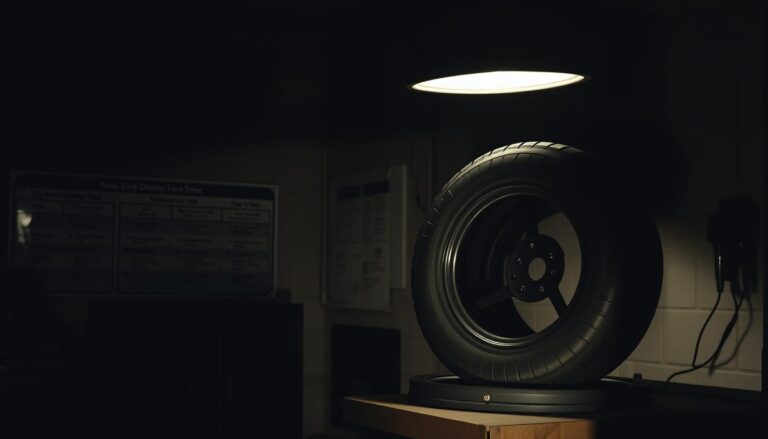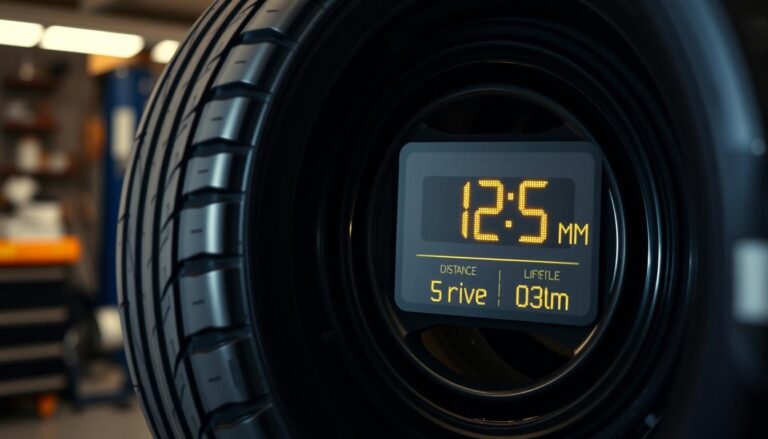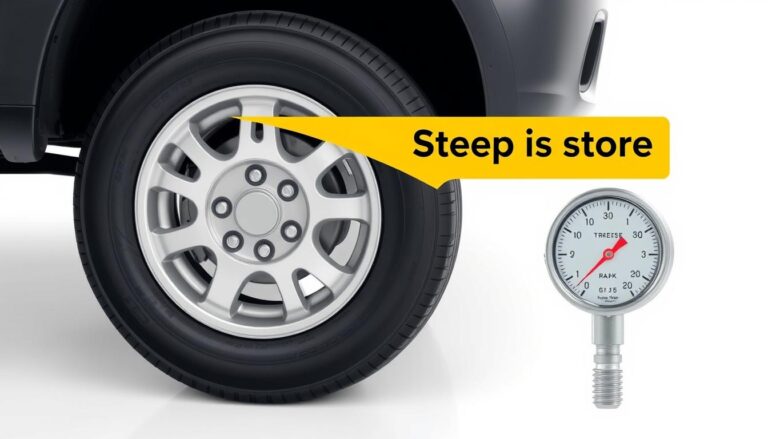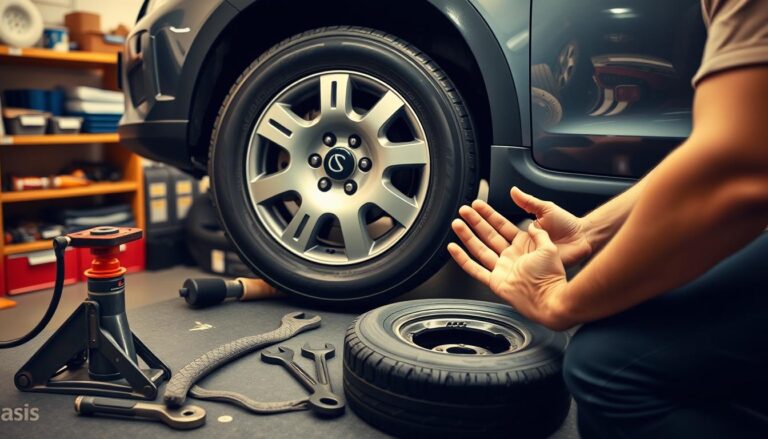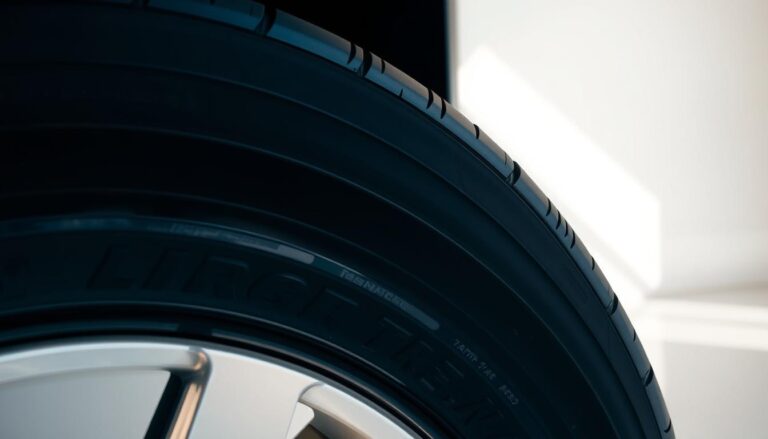How to Plug a Tire: Easy DIY Tire Repair
Getting a flat tire can turn a simple drive into a stressful moment. Learning to plug a tire can save you time, money, and stress. It’s a useful skill for car owners to handle small tire problems easily.
Flat tires don’t have to ruin your day. With the right tools and knowledge, you can fix a tire fast. This guide will show you how to do a quick and safe tire repair.
Knowing how to fix a tire is more than saving money. It’s about being ready for any situation. Whether on a busy highway or in a remote spot, you’ll be ready to handle tire emergencies.
Your safety and car’s health are key. While some tire issues need a pro, many small punctures can be fixed at home. This guide will teach you how to check damage, pick the right fix, and get your tire working again.
You’ll learn how to spot different types of punctures and fix them right. These tips are great for both new and experienced drivers. They’ll help you tackle any unexpected tire problems.
Understanding Tire Damage and When Repair is Possible
Tire puncture repair is a key skill for car owners. Not every tire damage needs a new tire. Knowing how bad the damage is is key for safety and saving money.
Knowing the different types of tire damage helps drivers decide on repairs. Some punctures can be fixed, but others need a new tire right away.
Types of Tire Punctures
- Tread Punctures: Small holes in the tire’s tread area
- Sidewall Punctures: Damage along the tire’s side wall
- Shoulder Punctures: Damage near the tire’s edge
Safety Considerations Before Repair
Before fixing a tire, check the puncture’s size and where it is. Repairing a tire needs care and knowing the risks.
| Puncture Location | Repair Possibility | Safety Risk |
|---|---|---|
| Tread Center | High | Low |
| Sidewall | Low | High |
| Shoulder Area | Medium | Medium |
When to Replace Instead of Repair
Some tire damage means you need a new tire. Big punctures, sidewall damage, or holes bigger than 1/4 inch need a new tire for safety.
- Puncture larger than 1/4 inch
- Multiple punctures close together
- Significant sidewall damage
- Tire age over 6 years
Knowing these rules helps car owners choose the right fix for tire punctures. It’s about safety and saving money.
Essential Tools and Materials for Tire Repair
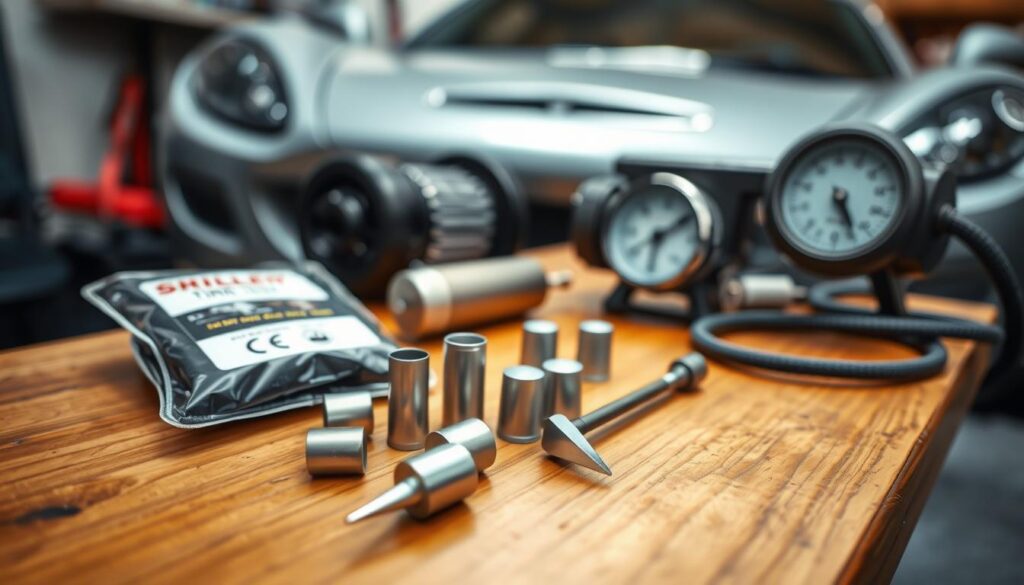
Getting ready for a tire repair means having the right tools. A good tire plug kit can save you time and money. It also helps avoid the stress of being stuck on the side of the road.
The key parts of a good tire repair kit are:
- Tire Plug Tool: A special tool for putting in tire plugs
- Rubber Cement: Seals the plug for a strong repair
- Tire Plugs: Rubber strips that fill in holes
- Reaming Tool: Prepares the hole for the plug
- Pliers: Good for removing dirt or objects from the tire
Choose a high-quality tire plug kit. Look for one with many plug sizes and tools for different repairs.
Always wear gloves and work in a bright, steady place when fixing tires. Make sure you have everything you need from your kit before you start.
Having a good tire repair kit can turn a bad situation into a fixable problem. Mechanics say it’s smart to keep one in your car for emergencies.
How to Plug a Tire: Step-by-Step Guide
Learning to plug a tire can save you time, money, and stress. This guide will show you how to fix minor punctures. You’ll be able to do it with confidence.
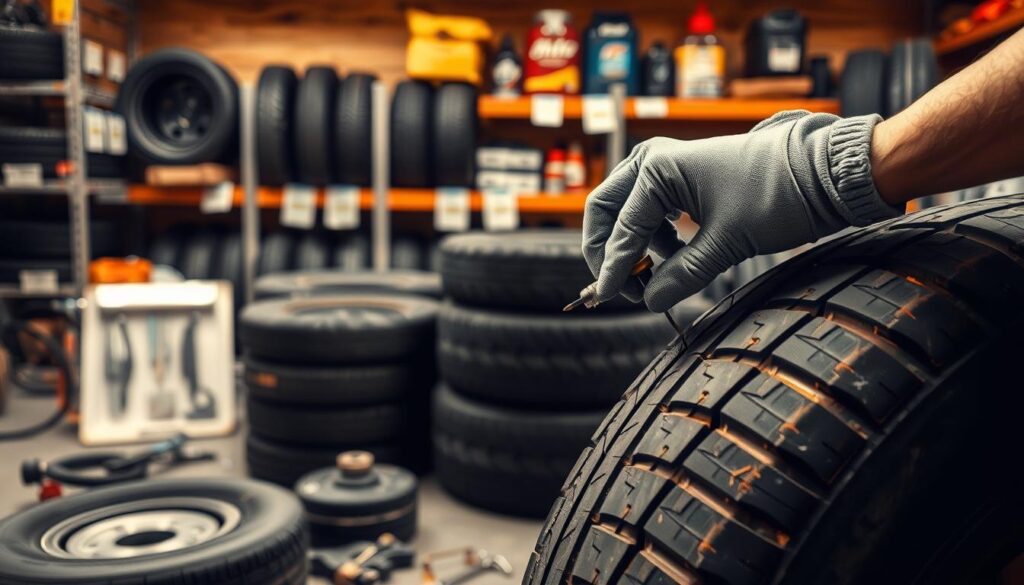
First, get your tools and safety gear ready. A good tire patch needs careful prep and execution.
Locating the Puncture
Finding the puncture spot is key. Here’s how:
- Inflate the tire to the right pressure
- Look for any visible damage
- Listen for air leaks
- Use soapy water to find small leaks (bubbles show up)
- Mark the spot with chalk or a marker
Preparing the Tire Surface
Getting the surface right is important for a good patch. Clean the area well:
- Clear out any dirt from the hole
- Use a tire repair rasp to make the area rough
- Apply rubber cement around the hole
- Let the cement get sticky
Installing the Plug
Now, it’s time to put in the plug:
- Put the plug through the tool
- Push it into the hole
- Cut off any extra plug material
- Check if the tire holds air
Pro tip: Always follow the manufacturer’s instructions. For big or sidewall punctures, consider a pro repair.
Common Mistakes to Avoid During Tire Repair
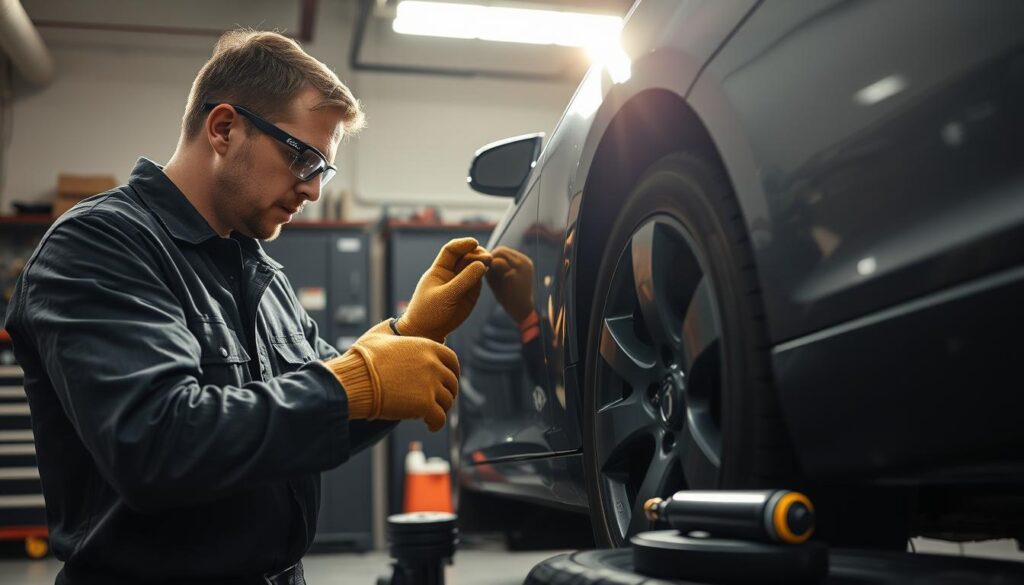
DIY tire repair can be tricky. Many car owners make critical errors that compromise their safety. Knowing these common mistakes can help you do a better and safer tire repair.
- Neglecting proper tire inspection before repair
- Using incorrect tire repair tools
- Attempting to repair extensive tire damage
- Skipping surface preparation steps
- Failing to check tire pressure after repair
One of the most dangerous mistakes in tire repair is underestimating the severity of tire damage. Not all punctures can be safely repaired. Experts say to check the puncture location, size, and tire condition before trying any DIY repair.
| Mistake | Potential Consequence | Recommended Action |
|---|---|---|
| Improper plug installation | Air leak, possible blowout | Make sure the seal is complete and use the right technique |
| Repairing shoulder/sidewall damage | Structural tire failure | Replace the tire right away |
| Using home remedies | Unsafe temporary fix | Use a professional tire repair kit |
Tire repair needs precision and knowing your vehicle’s specific needs. If unsure, always ask a professional to ensure your safety on the road.
Professional vs DIY Tire Repair: Making the Right Choice
Drivers often face a tough choice when their tires get punctured. They must decide between getting it fixed by a pro or doing it themselves. Each option has its own pros and cons that affect your car’s safety and your budget.
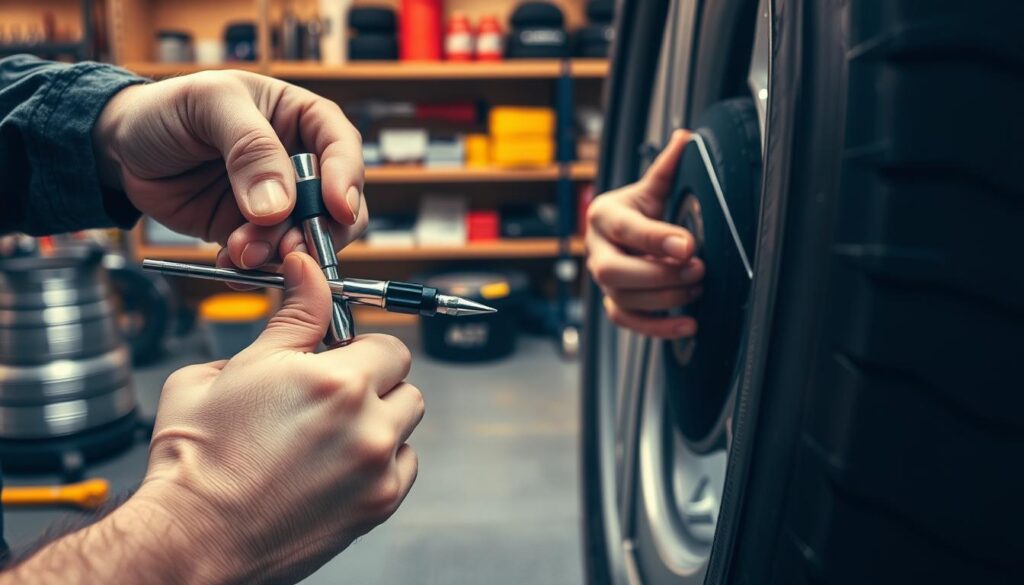
Knowing the details of tire repair helps you choose wisely. It’s about finding a balance between cost, time, and keeping your car in good shape.
Cost Comparison
Fixing a tire yourself is usually cheaper. A DIY kit can cost between $5 and $20. On the other hand, going to a professional can cost between $20 and $50 per tire.
- DIY repair materials: $5-$20
- Professional tire repair: $20-$50 per tire
- Potential savings with DIY approach: Up to 70%
Time and Effort Considerations
Getting a pro to fix your tire is quick and easy. Most shops can do it in 30-60 minutes. But, fixing it yourself takes more time and skill, usually 1-2 hours if you’re new at it.
Long-term Reliability Factors
DIY fixes work well for small holes. But, a pro can check your tire thoroughly. They can spot hidden damage that could be dangerous.
- DIY repairs work best for small punctures
- Professional repairs include thorough tire inspection
- Expert technicians can detect hidden tire damage
Choosing between DIY and professional repair depends on your skills and the damage. Always put safety first when deciding how to fix your tire.
Tire Maintenance Tips to Prevent Future Punctures
Keeping your tires in good shape is key to avoiding unexpected punctures. It also helps your tires last longer. By following a few simple steps, you can lower the chance of tire damage and save on repair costs.
There are a few important steps to keep your tires in top condition:
- Check tire pressure every month
- Rotate tires every 5,000-7,500 miles
- Get your wheels aligned once a year
- Check the tire tread depth often
Tire pressure is very important in preventing punctures. Underinflated tires are more likely to get damaged by road hazards. Always use a good tire pressure gauge to make sure your tires are at the right PSI.
| Maintenance Task | Frequency | Potential Benefits |
|---|---|---|
| Tire Pressure Check | Monthly | Reduces puncture risk by 40% |
| Tire Rotation | Every 5,000-7,500 miles | Ensures even wear |
| Wheel Alignment | Annually | Prevents uneven tire wear |
Checking your tires regularly can spot problems early. Look for:
- Unusual tread wear patterns
- Small embedded objects
- Sidewall damage
- Bulges or bubbles
Spending time on tire care not only stops punctures but also makes your car safer and run better. Professional tire repair services can offer more advice and detailed checks to keep your tires in great shape.
Emergency Roadside Tire Repair Techniques
Driving can sometimes lead to unexpected flat tires. Knowing how to fix them quickly is key to staying safe. It’s important to be prepared and know the right steps to ensure your safety.
In an emergency, your first step is to ensure your safety. Then, find a temporary fix to get you to a safe place. The goal is to assess the damage and choose the best emergency repair method.
Temporary Fix Solutions
For quick fixes, consider these options:
- Use a tire plug kit for small punctures
- Apply a tire sealant spray
- Utilize a compact spare tire
- Implement a tire inflation kit
When to Call for Professional Help
Not all flat tires can be fixed at home. Know when you need a pro:
| Tire Damage Type | Recommended Action |
|---|---|
| Sidewall puncture | Professional repair required |
| Large puncture (over 1/4 inch) | Immediate professional service |
| Multiple punctures | Tire replacement recommended |
| Damage near wheel rim | Professional inspection needed |
Always put safety first when dealing with a flat tire. Carry a reliable emergency tire repair kit. Also, know your car’s specific needs to handle roadside emergencies well.
Safety Testing After Tire Repair
Fixing a tire is just the start to keeping your car safe. It’s important to test the tire thoroughly. This makes sure the repair is solid and avoids any dangers on the road.
After fixing a tire, it’s key to do a safety check. This check looks for any problems that could affect how the tire works or the safety of your car.
- Do a visual check of the fixed area
- Use a good gauge to check the tire pressure
- Take a careful test drive in a safe area
- Watch the fixed tire for any odd behavior
Keeping your tires in good shape needs careful attention. Experts say it’s best to follow a detailed safety test after fixing a tire. You should look at:
- How well the seal is around the fix
- If the tire pressure stays steady
- The alignment of the wheel
- How well the tire is performing
It’s important to do a gentle test drive of about 10-15 miles. Listen for strange noises, feel for any shakes, and see how the car handles. If you notice anything off, get it checked by a pro right away.
While fixing a tire yourself can save money, safety comes first. If you’re unsure about the repair, get a pro to check it. They can give a full safety check.
Conclusion
Learning to plug a tire is a key skill for car owners. It can save you money and time. Plus, it makes you feel more in control of your car.
Fixing a tire yourself is easy for small holes. But, you should know when to call a pro. Some problems need expert help to keep your car safe and running well.
Knowing when to plug a tire is important. Always be safe, use good tools, and check your tires often. With the right skills, you can avoid getting stuck on the side of the road.
Tire care is an ongoing job. Keep learning about your car and don’t be afraid to ask for help. Safe driving starts with well-kept tires and knowing how to take care of them.
